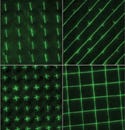March 1, 2006
R&D DIGEST
|
DNA strands fluoresce in these microscopic images from The Ohio State University (Columbus). The squares in the lower right image measure approximately 10 µm across. |
Uncoiled strands of DNA that have been formed into precise patterns could eventually be wired into biological electronics and medical devices. Researchers at The Ohio State University (Columbus) have developed a method to create simple, orderly structures that resemble quilt stitches in medical devices. The wires have the potential to be used in biosensors, molecular-based electrode circuits, and gene-delivery applications, according to the research team.
“Stretching DNA isn't totally new; it's been done by quite a few researchers. Our major contribution is that we can produce a very well-ordered array [of DNA],” says L. James Lee, professor of the department chemical and biomolecular engineering at Ohio State. “When designing electrode circuits, there has to be a specific pattern—it can't be just random wires. We believe our [method] is the first type where people can both stretch the DNA into nanowires and make them into exact patterns.”
First, the researchers must uncoil DNA strands. They press a rubber comb into a drop of water that contains DNA molecules. The strands stretch out along its surface as the comb is pulled out of the water. The comb is then placed on a glass chip, where it deposits DNA strands of various shapes and lengths.
Biosensors and gene delivery are the researchers' main applications of interest. “For the biosensors, we can stretch the DNA like a line,” says Lee. “Then we can put the primers in there and break down the DNA into a number of sections depending on its structures.” Using a microscope, the researchers examine the patterns, which look like a bar code, to identify what kind of DNA they're working with. Before moving further with this technology, Lee says they need to make sure that it can be applied with different types of DNA.
In the area of gene delivery, Lee would like to use the same approach to stretch the gene, or DNA, molecules. “By doing so, we'd be able to add the various functionalities to different locations on the DNA. Eventually people could use this method to functionalize the DNA and inject the delivery into the patient's body for gene therapy. This involves more challenging work down the road.”
Lee and Jingjiao Guan, his research associate, are working on increasing the density of the wires and making different patterns. The current patterns used on the DNA nanowires are simple straight lines aligned in a variety of ways. If curves or different shapes could be created with the wires, they could be used for electrode circuit designs. The DNA wires are currently about 5 µm apart from each other. Making the wires denser, 50 nm apart, for example, could provide applications for high-density electric circuits or memory chips, says Lee. He and Guan are joining with researchers at Ohio State's department of electrical and computer engineering to assess the wires' electrical properties.
The process of stretching the DNA also needs to be tailored for commercialization. “To make an industry-viable technology, we would like to develop a continuous process so that we can continue to stretch DNA on a pattern and then mass produce it at high throughput and a low cost,” says Lee. “Right now, we use a manual process just to demonstrate the concept.” The researchers are currently designing a process similar to a small-scale conveyor belt. This process would allow them to continuously stretch the DNA on the belt. The process would be useful in making low-cost biosensors. For gene therapy, it would provide a method to make a large quantity of functionalized DNA or genes.
Lee emphasizes that the research is still in its early stages. “We've just demonstrated feasibility,” he says. “To make it into a commercial [technology], there's a lot of research in front of us.”
Copyright ©2006 Medical Device & Diagnostic Industry
About the Author(s)
You May Also Like



